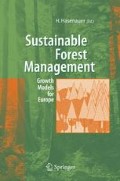Abstract
This chapter explains several multi-criteria decision analysis methods that can be used to systematise the evaluation of alternative forest plans. The discussed methods include SMART (the Simple Multi-Attribute Rating Technique), AHP (the Analytic Hierarchy Process), outranking methods, and voting methods. The second part of the chapter summarises various methods of heuristic search, which can be used to find good combinations of management alternatives for forest stands. The following heuristics area are explained: random ascent, Hero, simulated annealing, threshold accepting, great deluge, tabu search, and genetic algorithms.
Access this chapter
Tax calculation will be finalised at checkout
Purchases are for personal use only
Preview
Unable to display preview. Download preview PDF.
References
Bettinger P, Boston K, Sessions J (1999) Intensifying a heuristic forest harvest scheduling search procedure with 2-opt decision choices. Can J For Res 29:1784–1792
Bettinger P, Graetz D, Boston K, Sessions J, Chung W (2002) Eight heuristic planning techniques applied to three increasingly difficult wildlife planning problems. Silva Fenn 36(2):561–584
Borges JG, Hoganson HM, Falcão AO (2002) Heuristics in multi-objective forest planning. In: Pukkala T (ed) Multi-objective forest planning. Kluwer, Dordrecht, pp 119–151
Brans JP, Vincke P (1985) A preference ranking organization method. Manage Sci 31(6):647–656
Dowsland KA (1993) Simulated annealing. In: Reeves CR (ed) Modern heuristic techniques for combinatorial problems. Wiley, New York, pp 20–69
Edwards W (1971) Social utilities. Engineering economist. Summer Symp Ser 6:119–129
French S (1989) Readings in decision analysis. Chapman and Hall, New York, 210 pp
Hammond JS, Keeney RL, Raiffa H (1998) Even swaps: a rational method for making trade-offs. Harvard Business Rev March–April:3–11
Heinonen T, Pukkala T (2004) A comparison of one-and two-compartment neighbourhoods in heuristic search with spatial forest management goals. Silva Fenn 38(3):319–332
Kangas J, Kangas A (2002) Multiple criteria decision support methods in forest management. In: Pukkala T (ed) Multi-objective forest planning. Kluwer, Dordrecht, pp 37–70
Kurttila M, Pukkala T (2003) Combining holding-level economic goals with spatial landscape-level goals in the planning of multiple ownership forestry. Landscape Ecol 18: 529–541
Lahdelma R, Hokkanen J, Salminen P (1998) SMAA — stochastic multiobjective acceptability analysis. Eur J Operat Res 106:137–143
Laukkanen S, Kangas A, Kangas J (2001) Monitavoitteisen ryhmäpäätöstuen tekniikoita metsälön hoidon ja käytön suunnitteluun. Res Note 124. Faculty of Forestry, University of Joensuu, 60 pp
Lootsma FA (1993) Scale sensitivity in the multiplicative AHP and SMART. J Multi Criteria Decision Anal 2:87–110
Ma D, Zheng X (1991) 9/9–9/1 scale method of AHP. In: Proc 2nd Int Symp AHP, vol 1. University of Pittsburgh, Pittsburgh, Pennsylvania, pp 197–202
Pukkala T (2002) Introduction to multi-objective forest planning. In: Pukkala T(ed) Multi-objective forest planning. Kluwer, Dordrecht, pp 1–26
Pukkala T (2004) Dealing with ecological objectives in the Monsu planning system. Silva Lusi-tana 12:1–15
Pukkala T, Kangas J (1993) A heuristic optimization method for forest planning and decision-making. Scand J For Res 8:560–570
Reeves CR (ed) (1993) Modern heuristic techniques for combinatorial problems. Wiley, New York, 320 pp
Render B, Stair RM (1992) Introduction to management science. Allyn and Bacon, Boston, 856 pp
Roy B (1991) The outranking approach and the foundations of Electre methods. Theory Decision 31:49–73
Saaty TL (1980) The analytic hierarchy process. McGraw-Hill, New York, 287 pp
Salo AA, Hämäläinen RP (1997) On the measurement of preferences in the analytic hierarchy process. J Multi Criteria Decision Anal 6:309–319
Author information
Authors and Affiliations
Editor information
Editors and Affiliations
Rights and permissions
Copyright information
© 2006 Springer-Verlag Berlin Heidelberg
About this chapter
Cite this chapter
Pukkala, T. (2006). The Use of Multi-Criteria Decision Analysis and Multi-Objective Optimisation in Forest Planning. In: Hasenauer, H. (eds) Sustainable Forest Management. Springer, Berlin, Heidelberg. https://doi.org/10.1007/3-540-31304-4_17
Download citation
DOI: https://doi.org/10.1007/3-540-31304-4_17
Publisher Name: Springer, Berlin, Heidelberg
Print ISBN: 978-3-540-26098-1
Online ISBN: 978-3-540-31304-5
eBook Packages: Biomedical and Life SciencesBiomedical and Life Sciences (R0)

